Ecuador is located on the equator, which makes it an ideal place to visit for warm, sunny days any time of the year. We spent 17 days in Ecuador, from big cities like Quito and Guayaquil, to rural villages in Quilotoa, adventure towns like Baños, and the Galàpagos Islands which are like no other!
What You Need To Know Before You Go
- Speak in Spanish! The majority of the locals do not speak English – even the ones in the tourism industry! (You do not need to be fluent, but it is helpful to know some basic conversational language).
- Ecuador is a cash economy and uses the US dollar. Be prepared to use cash for everything, even paying for your accommodations.
- Enjoy freshly squeezed fruit juices daily!
- A typical meal is $3 and includes a soup, a plate of a protein (usually chicken, beef, or fish), rice, and a salad. They typically substitute egg as the protein for vegetarians.
- Although big cities like Quito and Guayaquil have a reputation for not being safe, it is mostly petty theft that is avoidable by being a vigilant traveler.
- The smaller villages felt very safe and welcoming to travelers!
Quito, Ecuador
Our adventure began jetlagged from our red-eye flight and a little unsteady from arriving at 2850m (9,350 feet) of altitude in Quito, the historic capital city of Ecuador, which has both old colonial architecture and modern influences.
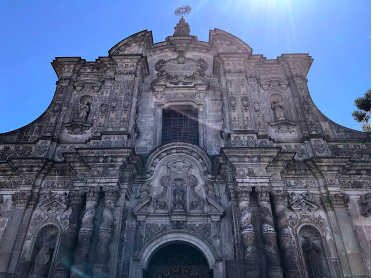
For the most authentic and most budget-friendly experience, we traveled with the locals on the green bus to Riococo – $2 for an hour and a half ride to the city center, where we then took a cab to the Secret Garden Hostel.
Although Quito has a reputation for petty theft, especially in bus stations, we felt surprisingly safe the whole time. Be aware of your surroundings and always keep your luggage under your arm. The friendly hosts at our hostel again warned us about petty theft when we went into the city – it is something to be aware of, but don’t let it ruin your trip or miss out on an experience.
The Secret Garden Hostel lives up to all of its great reviews. Our favorite feature is the rooftop restaurant with panoramic views of the city – from El Panecillo, the historic center, to the Basílica del Voto Nacional. We ate most of our meals here, and connected with other travelers from all over the world – many of whom had been traveling all throughout South America.
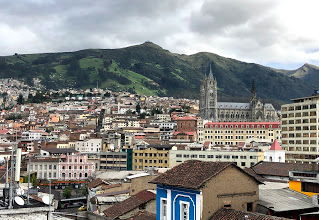
The hostel offers a Free Walking Tour through Carpe DM, the travel agency that operates in their front room. The tour lasted from 10am-2:30pm with a charming, English-speaking Ecuadorian guide. The tour included all the major sights that we wanted to see and more:
- We walked to the Basílica (which is adorned with animals native to Ecuador instead of gargoyles),
- Learned about their famous cultural dish, ‘cuy’ (guinea pig!) – though we did not try it,
- Visited an art museum where we were regaled with stories of history and culture,
- Tasted chocolate from different parts of Ecuador at the República del Cacao,
- Experienced the bustling main plaza and outdoor square,
- Practiced some salsa dancing atop a municipal building.
- Discovered the best $1 empanadas and the freshest papaya juice for lunch at a small, hole-in-the-wall restaurant.
- Walked down La Ronda – a popular and narrow cobblestone street lined with restaurants and small shops. The street comes alive at night, and it is where you can try canelazo, a traditional hot drink made of cinnamon with liquor.
- Ended at the mercado where we sampled the fresh and delicious tropical fruits.
After 24 hours in Quito, we took a public bus to the main bus terminal (Quitumbe), which brought us to Latacunga, the beginning and ending point of the Quilotoa loop.
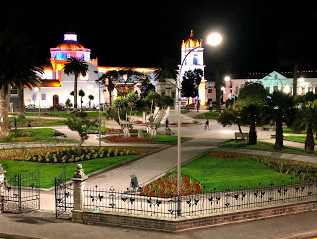
Hiking the Quilotoa Loop
There are so many possibilities for wrong turns, so having the maps.me app downloaded before you arrive is a must. Each day we hiked for about seven miles (4-6 hours), and then napped in a hammock when we arrived at the hostel, tired but happy from our trek and the sunshine. We ate dinner with other travelers, shared our experiences in Ecuador, and then began hiking again on our own the next morning.
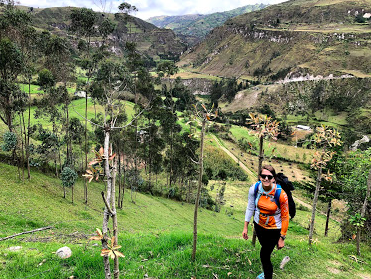
We backpacked 34-km over three days through a series of rural farming villages in the Ecuadorian Andes. Our journey climaxed in fierce wind atop the 12,840 ft volcano, where the Quilotoa lagoon rests in its crater. We saw more farm animals than people along our hike. There were lots of cows, pigs, horses, donkeys, chickens, and sheep…and maybe 1 or 2 hikers, and a handful of friendly locals that we encountered. For the most part, we had the gorgeously green land all to ourselves.
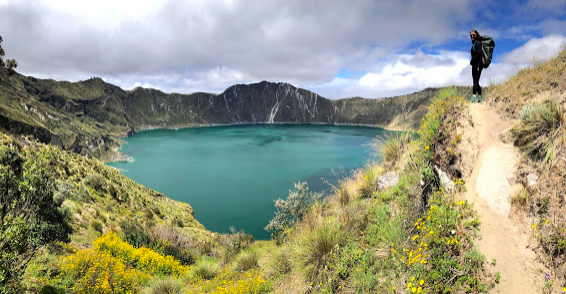
Baños de Santa Agua
Next, we spent five days in Baños de Santa Agua, which felt like the perfect amount of time to enjoy the town and all of the adventures it offers. We biked Ruta de las Cascadas (Avenue of the Waterfalls), which is a mostly downhill, 18-km ride with views of waterfalls along the way, and there are camionetas waiting to drive you and your bike back to the main part of town when you are done. The route culminates at El Pailon del Diablo (The Devil’s Cauldron) – a most powerful waterfall. There are two different entrances (each cost $2), and it is worth viewing from both sides. Bring a rain jacket and a water proof camera because you will get soaked from its splash and spray!
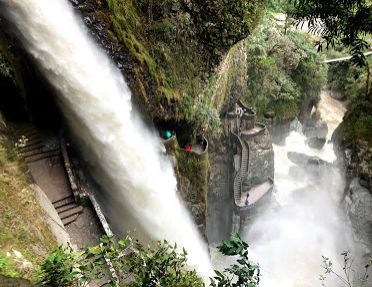
The next day we went canyoning down one of the waterfalls that we say on our bike ride the day before! Rappelling down the waterfalls was exhilarating, but be aware that they definitely have different safety standards than in the USA.
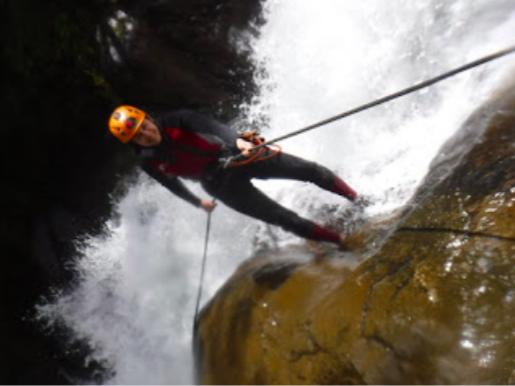
The Casa del Arbol is the treehouse of your childhood dreams with a swing on each side. You swing to an amazing view of the Tungurahua volcano, made even better at sunset. You can get there on a chiva bus with any of the tour companies in town for $5, but you can talk them into a discount. Earlier that morning we went ziplining over a gorge and through trees. There is so much natural beauty here that leaves you in awe.
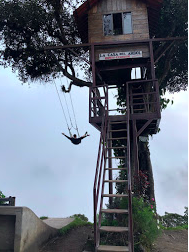
After being so active, we soaked in the thermal baths, after which the town (“Baños”) is named. There are several different thermal baths; we went to Termas de la Virgen because it is in walking distance from the main town. The rich minerals from the volcanic springs are believed to be healing (like a glorified Epsom salt bath), and the minerals are also what cause the warm water to look murky. However, it is kept very clean, you are required to shower before getting in the pools, and everyone must wear a lycra hair cap while in the water. We alternated between warming up in the hot springs and cooling off in the natural waterfall, just like the locals!
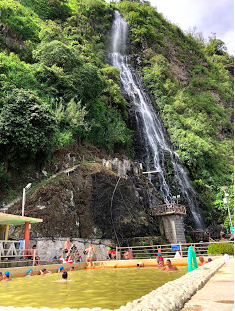
The most authentic and best-priced food is at the Mercado in the center of the town. We loved the llapingachos, which are grilled potato and cheese patties served with a side of rice, salad, and avocado. If you’re looking for a treat, Aromí has the best hot chocolate.
We enjoyed our stay at El Balcon de Cielo, which overlooks the San Francisco bridge and rushing ravine beneath it. You’ll see some bungee jumpers here every afternoon!
Guayaquil
From Baños, we took a seven-hour bus ride to Guayaquil, which is the largest and most populated city on the coast of Ecuador. Guayaquil is also has a bad reputation in terms of safety, so we stuck around La Bahia (one of the safest neighborhoods) for our short time in this city. We stayed at Manso Boutique Guest House for its location, and enjoyed walking along the waterfront on Malecon 2000 and marveled at all of the iguanas in Parque Seminario. The next morning, we caught our flight to the Galápagos Islands!
The Galápagos Islands
The Galápagos Islands are 600 miles off the coast of Ecuador and the only way to get to is a flight from either Guayaquil or Quito. 97% of the 18 islands are part of the National Park and is a UNESCO World Heritage Site. The wild and wonderful creatures that are abundant on the islands make it easy to see how they inspired Darwin’s theory of evolution.
On Santa Cruz Island, we learned about conservation at the Charles Darwin Research station, and saw tortoises of all ages – from babies to over 100 years old! We passed pink-tinged salt flats to get to Las Grietas, a natural swimming hole with cliff jumping and super clear water for snorkeling! The best time to go is on a sunny weekday at noon. For a lively outdoor dinner experience, eat at Los Kioskos. Tables are set up in the middle of the street and restaurants set out their fresh catches of the day. We stayed at Lonesome George Eco Lodge – it’s artsy, environmentally friendly, and they have bikes complimentary to explore the island.
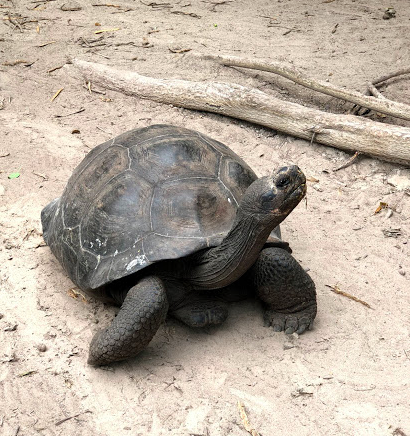
On our day trip to Isabela Island, we rented bikes to make the most of our time there. We visited the Tortoise breeding center, biked along El Muro de Las Lagrimas trail, visited the flamingo estuaries (the only way to see flamingos without a guide!), and ended with snorkeling at Conche de Perla, a lagoon near the main dock of Puerto Villamil. There are sea lions napping in the sun all over the dock, and others swimming playfully near the mangroves in the water below. I snorkeled with a giant sea turtle and bunch of fish!
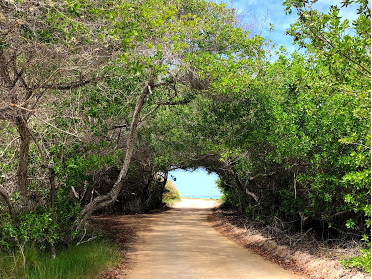
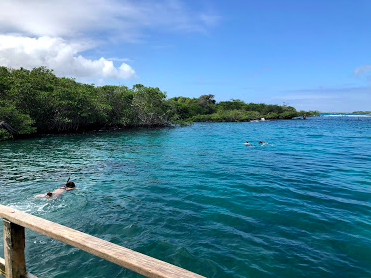
Our last few days on the Galápagos were spent on San Cristobal Island. Sea lions fill the beaches (and some of the walkways!). We took a nice walk up Cerro Tijeretas (Frigate Bird Hill) to the viewpoint, learned about the history of the Galápagos and the efforts to protect the wildlife at the Centro de Interpretación, and then continued along the path to Punta Carola beach for sunset.
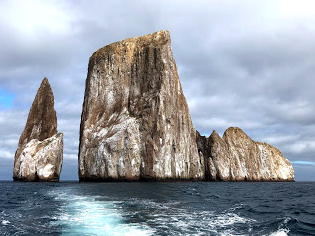
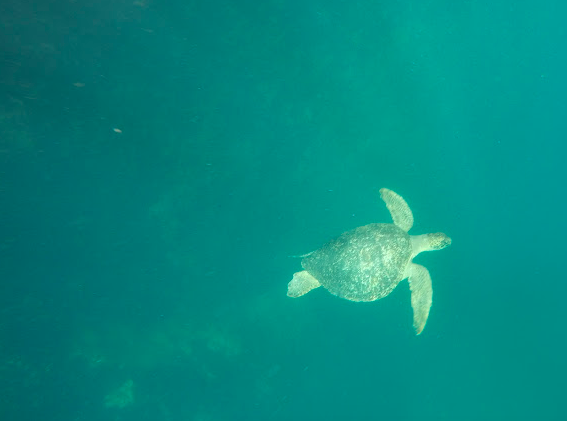
On our last day, we took a boat around the whole island on the 360 Tour. The cost is $150 per person for a full day adventure, and you can buy it from any vendor in town the day or two before you want to go. Our first stop was Kicker Rock, which contained the most beautiful underwater world. There were fish and turtles everywhere, and sharks if you dove down deeper! Cerro Brujo is a natural arch rock in beautiful blue ocean water that you’ll want to have your camera ready for. There were more snorkeling opportunities at Bahía Sardina (where you can see rays) and Bahía de Rosa Blanca (where we saw more sea turtles, fish, and some sharks dwelling at the bottom).
Have you been to Ecuador?




